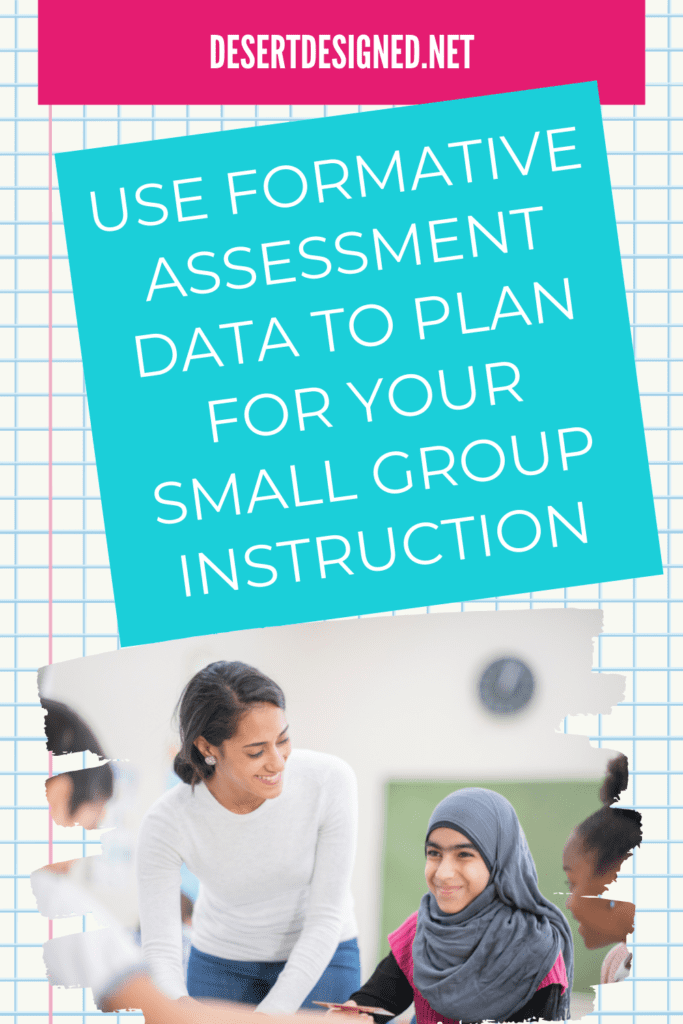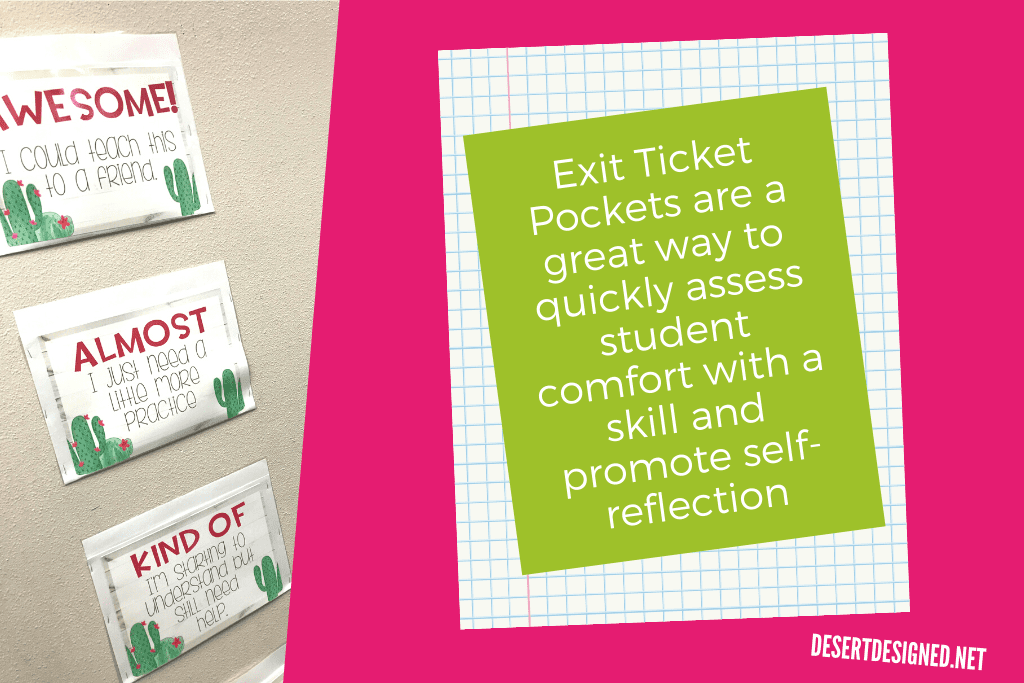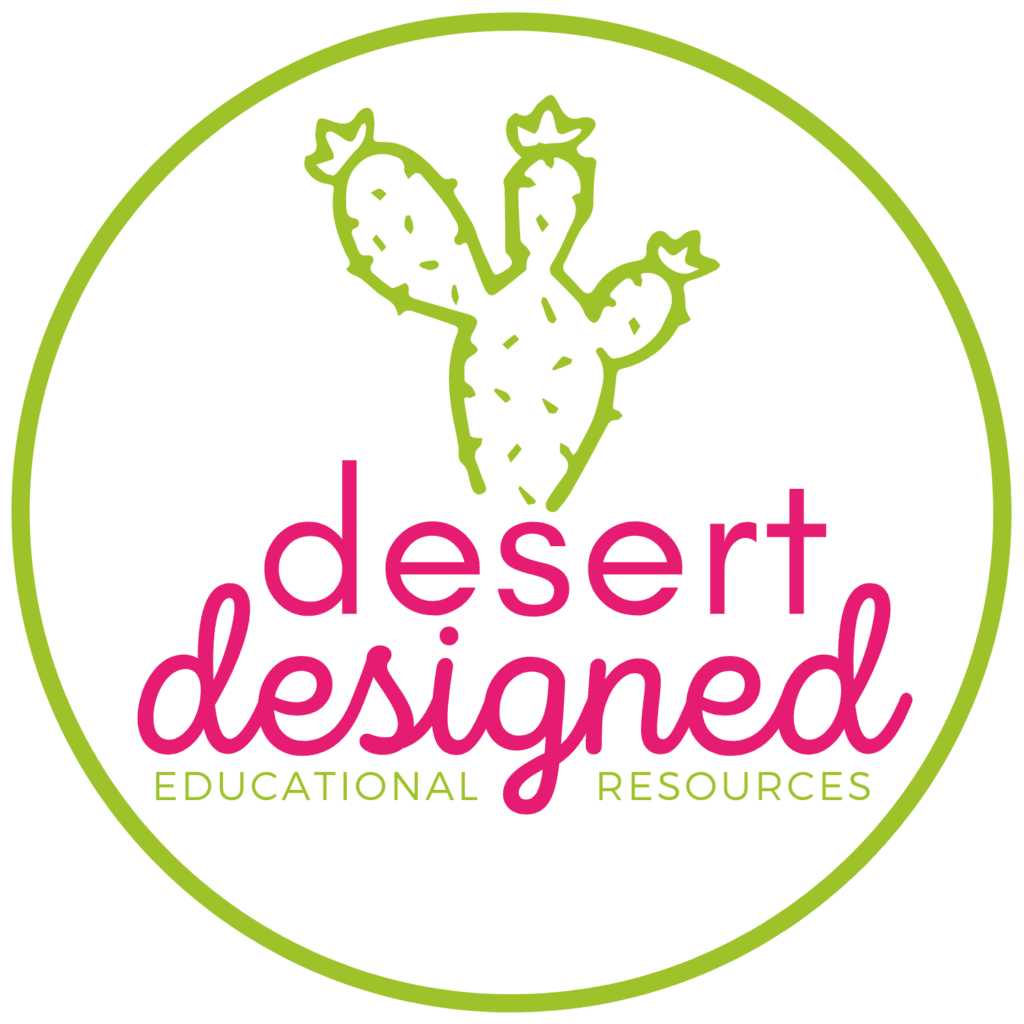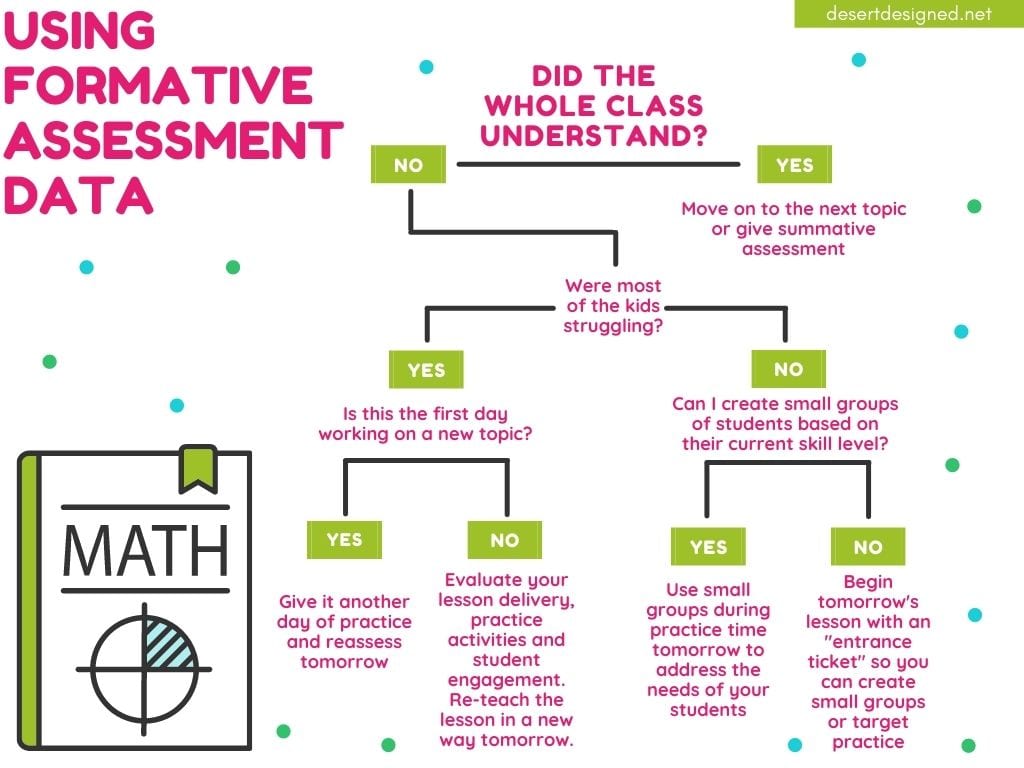Are you struggling to find enough formative assessment examples to use in your classroom? Formative assessment is a key to guiding your math instruction in a direction that is most useful to your student’s needs. The problem is, we often need to keep students engaged and not over-test them throughout our math lessons. Every class of students we have is different and comes to us with a different skill set. If we assume that all students have the same abilities, we are doing everyone a great disservice.

Formative assessment is essential for creating quality math lessons.
Do you struggle with what to do about the formative assessment data you gather? Click here to download a PDF flow chart for using formative assessment data!
What is Formative Assessment?
You will use formative assessment WHILE you are teaching or BEFORE you teach a skill. On the other hand, summative assessment happens AFTER you expect content mastery. You might be wondering about the point of using assessment while students are still learning.
Why Should I Do Formative Assessment?
Doing formative assessment will give you valuable data. You can use this data to learn more about your students and to guide and shape your math instruction.
With formative assessment:
- You can discover what your students know before you ever begin a lesson.
- Plan activities according to the current abilities and skill set of your class.
- Group students strategically for maximum benefit.
- See if your students are ready to move on or if they need more time practicing a skill first.
- Discover if a style of teaching or type of lesson is worth doing with your class.
What are Some Formative Assessment Examples?
Observation as a Formative Assessment Example
Formative assessment in mathematics does not need to be a formal assessment. Many teachers do not realize that by simply observing their students as they work, they could be collecting formative assessment data for their class.
Some teachers do this intuitively and can retain the information without writing it down, but most of us need to record this data. I have tried recording this information in many different ways over time and have struggled with several suggested strategies. Here are some of my struggles when I try recording my formative assessment data:
- Getting wrapped up in working with the kids and forget to record things.
- Feeling overwhelmed by my class size (often 36 kids or so).
- I get distracted by dealing with student behaviors or other teacher duties.
- It can be challenging to get around to the entire class, so I give up.
I have developed a method that helps me with all of this. I call it the Three Pass Walk-Around. (Fancy name, right?)
First, I write the skill we are working on on a sheet of paper and attach it to a clipboard. (It can be helpful to have this ready before the lesson begins to save time).
Next, if the skill has component skills, I make sure I make categories or columns with these at the top. For example, if we are doing long division, students need to know division facts, subtraction, and the steps to the process. I know if they are struggling, it is likely one of these specific areas.
Once my kids start their independent work, about a minute or two in, I do a quick pass around the room. I ONLY write down the students’ names who struggle in one of the areas I wrote down.
Then, I put down my clipboard and work with my students.
About midway through practice time (or working with groups), I grab the clipboard again and repeat the process in the last few minutes of working. If I notice a student struggling in a new area, I note their name. When students show improvement or their earlier struggle was likely a fluke, I cross their name off. I will check or highlight the names of students who are still having difficulty.
Now that I have my list, I have a good sense of how the students are performing overall and the capabilities of individual students. If a student’s name is missing from the list, I know that they were not struggling today. Is the list pretty empty? If so, we are ready to move on. Is one area a hot mess of names? Mini-lesson for tomorrow! Can I use this list to make some small groups for guided math instruction tomorrow?

You might be wondering how this works if students are absent? Right at the beginning, I make a little absence list at the bottom of the page, so I know who will likely be needing the lesson when they return.
Using Exit Tickets (With a Twist)
One of my favorite examples of formative assessment is the exit ticket. This name may sound odd since the students might not physically leave the classroom but think of it as an exit from the lesson.
I do something a little different with exit tickets than many teachers I know. I have folders posted on the wall. (Or you could use bins or mailboxes). These pockets have comfort zone descriptors. These are available for purchase in my store in both a cactus and bright polka dot theme.

Towards the end of the math lesson, I give students 2-3 questions to solve on a sheet of paper. The requirements are that they write their name on their form and try their best. Next, they have 3-5 minutes to do their best with the problems as given. Finally, I have them place their exit tickets into the correct folder or bin to describe their comfort with the concept.
Here are some of my favorite things about using this method:
- Get a good overall feel for the comfort of my class as a whole.
- Pull the tickets from the HELP file and see what those students are doing with the math without sorting through every paper.
- I quickly glance through the ‘I Could Teach this to Someone’ pile and make sure the students know what they are doing. If these kids have got it, but I need to re-teach tomorrow, I will find them an extension activity to complete.
- Using pockets is a total time saver.
- When I am REALLY out of time, I will have my students turn in the day’s practice work using this method instead of making up additional problems.
Using Entrance Tickets
Entrance tickets are almost identical to an exit ticket, but we use them at the beginning of a lesson instead of at the end. To use an entrance ticket, I post 1-3 math problems and give the students just a few minutes to complete them. As they work, I cycle the classroom to see how the students are approaching the problem.
After we have finished, I usually provide the correct answer or walk through how to solve the problem. Then, I have students indicate how comfortable they were with completing the problem by finger signals.

I don’t usually love public displays of confidence, especially since there are likely both struggling and extremely confident students in the class. However, when doing an entrance ticket, you must move quickly into the meat of the lesson. After ample time in the school year and creating a supportive learning environment for my students, this becomes less of an issue.
I use entrance tickets when:
- I want to see if students retained the information from the day before or over a weekend.
- Starting a new topic without a pre-test
- I need students to self-assess
Using Google Forms for Formative Assessment
Google Forms are a great way to get quick statistical data about student’s ability since they are self-grading. The key to using Google Forms for formative assessment is to keep them short. They should not be a full-blown test but provide just enough information to make decisions about your lessons.
You can create your own quick Google Form assessments or purchase them pre-made.
Using Boom Cards
Boom Learning Cards are a great way to gather formative assessment data for your students. If you want to collect individual student data, you will need a Boom Learning account, but you may be eligible for a free trial if you have not previously registered.
In Boom Learning, you can purchase or create and assign Boom Cards decks specific to the skill you are teaching. I have created a substantial growing bundle of 5th-grade math Boom Cards that covers every fifth-grade math standard you might need to teach.
After students in your class have completed the deck, or when the time is complete, both you and they can check their data for their performance on the cards you assigned.
Here is a sample of data I found under the reports tab after navigating to my class in Boom Learning.
I love that we can get data even if the students have not finished all of the cards in the deck. Being able to see how long students spent doing the work is very helpful. Also, it is beneficial that the students also have access to their data. Many other online platforms reserve data for the teachers.
What I love about Boom Learning above other online programs is the ability to target the precise skill I am working on in a particular way. I find that with many other online programs, the skills quickly become mixed, or the students only practice a few problems before they move on to the next skill. To learn more about getting started with Boom Learning in your classroom, check out this post. I’ve also written about different ways you can use Boom Cards with your students here.
What Should I do with the Data I Gather from Formative Assessment Examples?
Now that you have gathered formative assessment data through multiple examples, you must use that data to shape your instruction somehow. This flow chart demonstrates the decision-making process I go through as I think about using my formative assessment data.
Click here to download the above PDF flow chart for using formative assessment data!




